If you live in an apartment or perhaps there are rooms in your home that receive less direct sunlight than others, you may be a bit reticent about locating houseplants in these darker spots. If you love houseplants and miss having a bit of green in these low-light areas, fear not!
Some houseplants do exceptionally well in low-light conditions and other plants will adapt well to low light conditions. They may grow more slowly, but they do, nonetheless, thrive.
Each houseplant has specific needs and will require varying levels of care and maintenance. It might be easier if all plants were equal, but it certainly wouldn’t be as much fun or bring the same amount of satisfaction when you see them thrive.
Two of the principal differences we encounter in indoor gardening are how much water plants require and how much natural light they need.
While most of us may start out cultivating indoor plants thinking that they need tons of bright natural sunlight exposure to grow green leaves, that’s not really true. Several plants actually thrive more when exposed to less light.
Less light, however, does not mean “no” light. Plants that do well in low-light conditions will need some amount of indirect sunlight to survive.
Here is our list of 28 best low-light houseplants plus 2 surprises to grow and love.
1. Arrowhead Plant (Syngonium podophyllum)
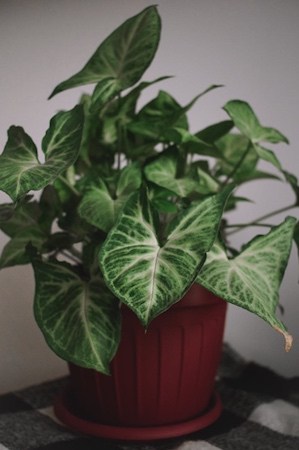
A vining plant native to regions in Central America, the Arrowhead Plant (Syngonium podophyllum) does very well in a low light environment. It boasts beautiful green foliage but can produce variegated leaves or leaves bronze in hue.
If you purchase a baby or very young plant, it will appear as a low bush or mound. But it will begin to vine sooner than you think. As a vining plant, it is perfect for trellis climbing or hanging baskets.
If you want bushier growth, pinch your plant to stop it from appearing leggy. Water when the soil bed is dry to the touch, and position in low to medium indirect light.
- Light: Low to medium indirect light
- Water: When the soil is dry to the touch
- Size: Can grow up to 3-6 feet depending on conditions
- Leaf Colors: Green, variegated, bronze
- Difficulty of Care: Easy, great for beginners
2. Cast Iron Plant (Aspidistra elatior)
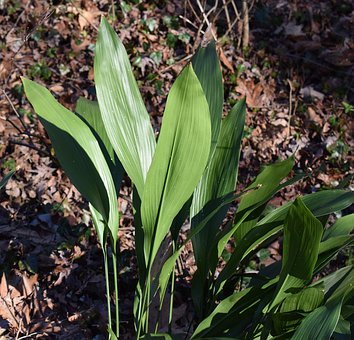
As the name implies, this is a plant that will feel like it was literally cast in iron, thriving on neglect. The Cast Iron Plant (Aspidistra elatior) requires very little from plant parents as it thrives in low light levels and only requires occasional waterings.
As a slow grower, it rarely needs to be repotted, so it asks very little in return for providing attractive elongated green foliage to dress up your home or office décor. Water it when you feel the top couple inches of the soil is dry.
- Light: Low light
- Water: When the top 2 inches of soil are dry
- Size: Usually between 1-2 feet
- Leaf Colors: Deep green
- Difficulty of Care: Very easy, almost thrives on neglect
3. Chinese Evergreen (Aglaonema)
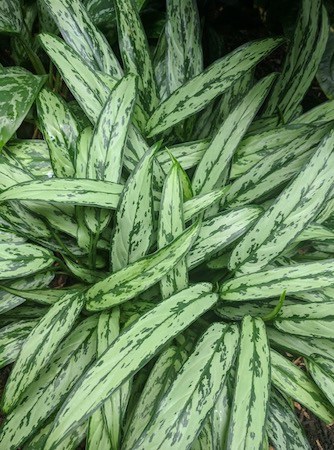
The Aglaonema or Chinese Evergreen is one of today’s most popular low-maintenance houseplants. It features lovely, elongated oval-shaped leaves that are truly decorative anywhere it is placed. It is a forgiving plant, as it can manage with both dry soil and a bit of overwatering.
Treated well, it will reward you with the growth of full luscious foliage. Pay attention to colors, as green-colored Chinese evergreens do better in low light conditions. New hybrids with colorful leaves will require medium light. The Aglaonema generally prefers low light or indirect light at the most.
- Light: Low to medium indirect light
- Water: Can tolerate both dry soil and a bit of overwatering
- Size: 1-3 feet
- Leaf Colors: Green, some have variegated leaves
- Difficulty of Care: Easy to moderate, depending on the variety
4. Dracaena Fragrans (Corn Plant)
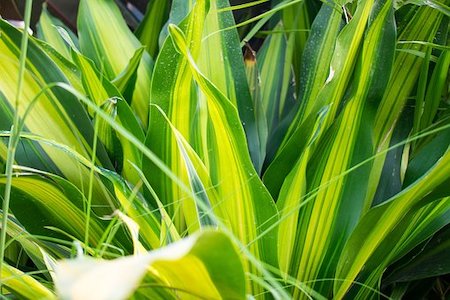
Prefer a taller bright shiny floor plant? Consider a Corn Plant botanically called the Dracaena fragrans. Often sold as an indoor tree reaching heights of up to six feet, it is a stunning bright addition to any room.
If the green leaves fade, simply remove them. When the top of the soil is dry, you can water it. Place the plant in a spot where it will receive low light or indirect light.
This is a toxic plant if you have pets. Low light and moderate humidity make for a happy Dracaena.
- Light: Low to medium indirect light
- Water: When the top of the soil is dry
- Size: Up to 6 feet
- Leaf Colors: Green, some varieties have yellow streaks
- Difficulty of Care: Moderate, needs occasional pruning
5. Golden Pothos (Epipremnum aureum)
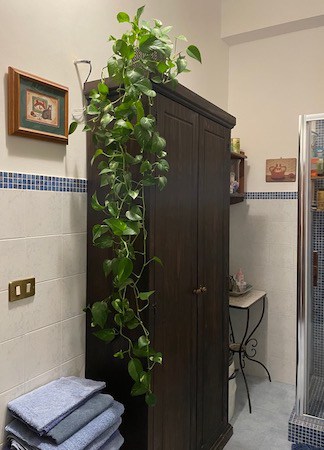
The Golden Pothos, Epipremnum aureum, is most probably in direct competition with the Philodendron as one of the easiest houseplants to cultivate. A vining plant, it will climb poles and trellises, or flow downward from cascading hanging baskets.
The pothos is often confused with the philodendron for their similar appearances. It comes in quite a few variegated choices that boast chartreuse to dark green, white/green, or yellow/green versions.
The pothos thrives in just about any spot in the home, but needs to be kept out of direct light. Low to medium indirect light is preferred. It likes moist soil, so water when the top of the soil is dry.
Water when the soil bed is dry to the touch and position in low or medium indirect light.
- Light: Low to medium indirect light
- Water: When the soil is dry to the touch
- Size: Vining, can be trimmed to desired length
- Leaf Colors: Chartreuse to dark green, white/green, or yellow/green variegated
- Difficulty of Care: Easy, great for beginners
6. Peperomia Obtusfolia
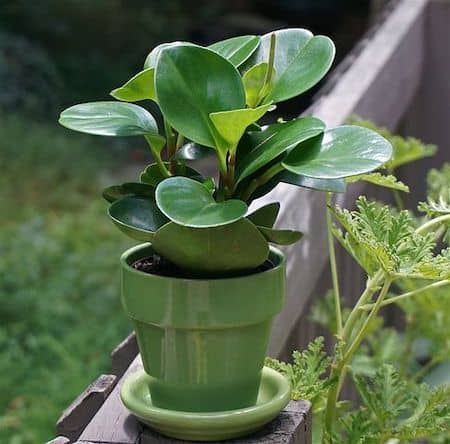
Peperomia are beautiful low-growing plants, making them ideal for dish gardens or terrariums. They won’t grow higher than ten inches tall, so if you have a smaller place for a plant, this one may be a perfect choice.
Available in various shapes of foliage and colors, its natural habitat is the rain forest, meaning it likes humidity. If you’d like some green in a bathroom that doesn’t have the best sun exposure, the peperomia plant will be a happy resident.
Make sure it has well-drained soil and gets low to medium indirect light. Bright light won’t help this low-light indoor plant grow faster.
- Light: Low to medium indirect light
- Water: Prefers well-drained soil, water when top of soil is dry
- Size: Up to 10 inches
- Leaf Colors: Green, some varieties are variegated
- Difficulty of Care: Easy, low maintenance
7. Philodendron Plant
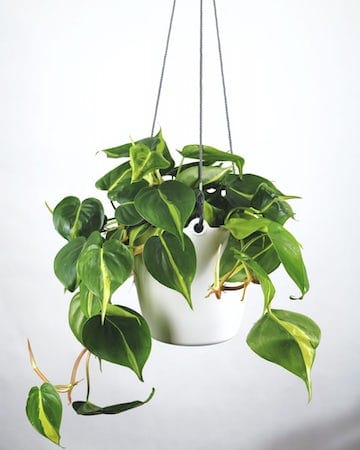
The Philodendron is a great low-maintenance houseplant and happy to grow in darker locations. These plants are rapid-growing viners that look great cascading down from a hanging basket or atop a high shelf. They are also quite forgiving if you happen to forget to water them.
Dark green heart-shaped satiny leaves will reward you wherever you choose to locate one. Stems can reach eight feet in length, so place them where vines can flow downward or pinch them to achieve fuller, bushier growth.
Give it some water when the top couple inches of soil are dry. It’lll do well in indirect, low to medium light.
- Light: Low to medium indirect light
- Water: When the top couple inches of soil are dry
- Size: Vines can reach up to 8 feet
- Leaf Colors: Dark green, satiny finish
- Difficulty of Care: Easy, quite forgiving
8. Prayer Plant (Maranta leuconeura)
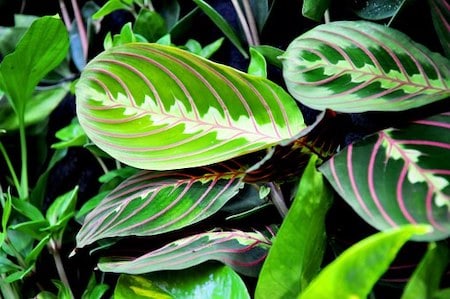
The Prayer Plant is one of the best small indoor plants, making it perfect for tabletops and smaller spaces. Botanically named Maranta leuconeura, it’s a tropical plant that features tricolored foliage of green, red, and yellow. It is called the “Prayer Plant” due to the foliage movement. The leaves lay flat in the daytime and fold upward in prayer during the night.
This low-maintenance plant likes warm temperatures and a certain amount of humidity, making it a good choice for bathrooms or even kitchens. The Prayer plant does very well in low light conditions because sunlight exposure will burn its beautiful leaves.
It can be positioned near a north-facing window. Low light and moderate to high moisture will help this plant thrive.
- Light: Low to medium indirect light
- Water: Keep the soil evenly moist
- Size: Up to 12 inches
- Leaf Colors: Green, red, and yellow tricolored
- Difficulty of Care: Moderate, likes consistent moisture and humidity
9. Snake Plant (Sansevieria)
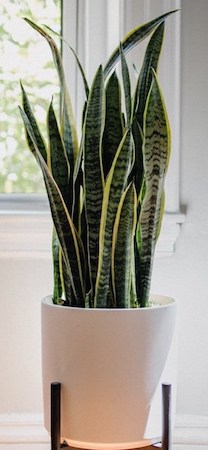
If you want a plant that is almost impossible to damage or kill, the Snake plant or Sansevieria is the houseplant to select. These plants are perfect for any corner or windowless space in your home or office.
It is a kind of succulent, so its foliage retains water. With this plant, you will need to take care to not overwater as opposed to forgetting to water it. Water every three to four weeks and only if the soil has dried.
It’s a lover of low-light situations, perfect for travelers or for offices closed on the weekends.
- Light: Low to bright indirect light
- Water: Every 3-4 weeks, only when soil is dry
- Size: Up to 3 feet
- Leaf Colors: Green, some have yellow or white edges
- Difficulty of Care: Very easy, great for beginners
10. ZZ Plant (Zamioculcas zamiifolia)
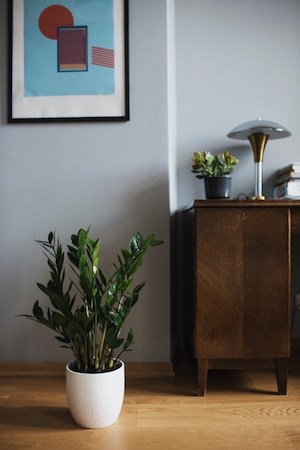
Zamioculcos zamiifolia otherwise affectionately called the “ZZ Plant” is one of our top two low-light plant choices together with the Sansevieria. The ZZ can sit in a dark corner or even in a room without windows if there are fluorescent lights, making it perfect for offices, workshops, or commercial businesses.
A native of Africa, it does well in very arid conditions, so if you are forgetful when it comes to watering, or travel frequently, the ZZ is the plant for you. It looks great as a floor plant as it features long stems that grow upright with luscious dark and glossy leaves.
This is a houseplant that is relatively independent and forgiving in nature, even when somewhat neglected. Water when the top inch of the soil bed dries out and place in a spot with low to medium indirect light.
- Light: Low to medium indirect light
- Water: When the top inch of soil is dry
- Size: Up to 3 feet
- Leaf Colors: Dark green, glossy
- Difficulty of Care: Easy, perfect for neglectful owners
11. Spider Plant (Chlorophytum comosum)
The Spider Plant is a champion when it comes to air purification, backed by studies from NASA’s Clean Air Study.
It’s a versatile and easy-to-care-for plant that adapts well to a variety of light conditions, including low light. Its long, arching leaves make it ideal for hanging baskets or elevated planters.
- Light: Low to bright indirect light
- Water: When the top inch of soil is dry
- Size: 1-2 feet
- Leaf Colors: Green and white variegated
- Difficulty of Care: Easy, suitable for beginners
12. Calathea (Calathea spp.)
Calathea is known for its striking leaf patterns and colors, making it a popular choice among indoor gardeners.
The plant is native to tropical rainforests, where it thrives under the canopy in low light conditions. I
t’s been studied for its ability to improve indoor air quality and is perfect for adding a touch of the tropics to your space.
- Light: Low to medium indirect light
- Water: Keep soil consistently moist, but not waterlogged
- Size: 1-2 feet
- Leaf Colors: Green with purple, white, or pink patterns
- Difficulty of Care: Moderate, prefers high humidity
13. Ficus Elastica (Rubber Plant)
The Ficus Elastica, commonly known as the Rubber Plant, is another excellent choice for low-light conditions.
Its large, glossy leaves add a dramatic touch to indoor spaces. Scientifically, it’s proven to be effective at improving indoor air quality by removing pollutants like formaldehyde.
- Light: Low to medium indirect light
- Water: When the top inch of soil is dry
- Size: Up to 10 feet
- Leaf Colors: Dark green, some varieties have pink or yellow variegations
- Difficulty of Care: Moderate, sensitive to overwatering
14. Boston Fern (Nephrolepis exaltata)
Boston Ferns are a popular choice for homes and offices because they adapt well to low-light conditions.
They are also known for their air-purifying capabilities, effectively removing pollutants like xylene and toluene. These ferns prefer a bit more humidity, making them ideal for bathrooms or kitchens.
- Light: Low to bright indirect light
- Water: Keep soil consistently moist
- Size: Up to 2-3 feet wide
- Leaf Colors: Light to dark green
- Difficulty of Care: Moderate, prefers high humidity
15. Lucky Bamboo (Dracaena sanderiana)
Lucky Bamboo is a popular houseplant for its ability to thrive in water alone, without soil. It prefers indirect light and can survive in low-light conditions.
In Feng Shui practices, this plant is believed to bring good luck and fortune.
- Light: Low to moderate indirect light
- Water: Keep water level consistent
- Size: Up to 3 feet
- Leaf Colors: Light green
- Difficulty of Care: Easy
16. Monstera Deliciosa (Swiss Cheese Plant)
Often called the “Swiss Cheese Plant” for its unique, holey leaves, the Monstera Deliciosa does well in low to moderate light.
The unusual leaf structure has fascinated botanists, leading to studies about its natural habitat and adaptability.
- Light: Low to bright indirect light
- Water: When the top inch of soil is dry
- Size: Up to 10 feet
- Leaf Colors: Dark green
- Difficulty of Care: Moderate, needs occasional pruning
17. Staghorn Fern (Platycerium bifurcatum)
Staghorn Ferns are unique, epiphytic plants that make for great wall art due to their antler-like fronds. They are suitable for low-light conditions but appreciate some indirect light.
Staghorn Ferns are known for their unique way of gaining nutrients; they absorb water and nutrients through their leaves rather than roots.
- Light: Low to moderate indirect light
- Water: Mist leaves regularly
- Size: Up to 3 feet
- Leaf Colors: Green with brown basal fronds
- Difficulty of Care: Moderate, requires regular misting
18. English Ivy (Hedera helix)
English Ivy is a popular trailing plant that can adapt to various lighting conditions, including low light.
Its air-purifying capabilities have been mentioned in studies, especially its ability to remove benzene and formaldehyde from the air.
- Light: Low to bright indirect light
- Water: When the top inch of soil is dry
- Size: Vines can trail up to 9 feet
- Leaf Colors: Dark green, sometimes variegated
- Difficulty of Care: Easy to moderate, needs regular pruning
19. Wax Begonia (Begonia semperflorens)
Wax Begonias are known for their waxy leaves and colorful blooms. They can adapt well to low-light conditions but prefer some indirect light for blooming.
These plants are often used for ornamental purposes due to their vibrant colors.
- Light: Low to bright indirect light
- Water: When the topsoil feels dry
- Size: Up to 18 inches
- Leaf Colors: Green or bronze, with white, pink, or red flowers
- Difficulty of Care: Easy to moderate
20. Parlor Palm (Chamaedorea elegans)
Parlor Palms are a classic choice for adding a tropical touch to low-light areas. They are relatively easy to care for and grow slowly, making them ideal for indoor spaces.
The Parlor Palm is often used in Victorian-era parlors, hence its name.
- Light: Low to moderate indirect light
- Water: Keep soil consistently moist
- Size: Up to 4 feet
- Leaf Colors: Green
- Difficulty of Care: Easy
21. Dragon Tree (Dracaena marginata)
The Dragon Tree is a popular member of the Dracaena family and is known for its sword-like, red-edged leaves. It’s an excellent plant for beginners and does well in low-light conditions.
The plant is also recognized for its air-purifying qualities, capable of removing pollutants like formaldehyde.
- Light: Low to moderate indirect light
- Water: When the top inch of soil is dry
- Size: Up to 6 feet
- Leaf Colors: Green with red or purple edges
- Difficulty of Care: Easy
22. Polka Dot Plant (Hypoestes phyllostachya)
Polka Dot Plants are named for their striking leaf patterns. While they can adapt to low light, they do prefer some indirect light to maintain their vibrant colors.
They are relatively easy to care for but do like a consistent watering schedule.
- Light: Low to bright indirect light
- Water: Keep soil consistently moist
- Size: Up to 2 feet
- Leaf Colors: Green with pink, red, or white spots
- Difficulty of Care: Easy to moderate
23. Guzmania (Bromeliad Guzmania)
Guzmania is a type of bromeliad that’s known for its vibrant, long-lasting flower spikes. While they can tolerate low light, they do prefer indirect light for optimal flowering. They are relatively low-maintenance and get most of their nutrients from their central tank, formed by their leaves.
- Light: Low to moderate indirect light
- Water: Fill central tank with water
- Size: Up to 18 inches
- Leaf Colors: Green with red, orange, or yellow flowers
- Difficulty of Care: Moderate
24. Yucca Cane (Yucca elephantipes)
Yucca Cane plants are known for their long, spiky leaves and their ability to tolerate a range of lighting conditions, including low light. They are drought-tolerant and are ideal for people who might forget to water their plants regularly.
- Light: Low to bright indirect light
- Water: When the top half of soil is dry
- Size: Up to 8 feet
- Leaf Colors: Dark green
- Difficulty of Care: Easy
25. Nerve Plant (Fittonia spp.)
The Nerve Plant is well-known for its striking vein patterns on the leaves, which can come in white, pink, or red. While it can adapt to low light, the colors are more vivid with indirect light.
It enjoys high humidity and can be a little challenging for beginner plant parents.
- Light: Low to bright indirect light
- Water: Keep soil consistently moist
- Size: Up to 1 foot
- Leaf Colors: Green with white, pink, or red veins
- Difficulty of Care: Moderate to challenging
26. Wax Plant (Hoya carnosa)
The Wax Plant, or Hoya, is a trailing plant that is known for its waxy leaves and sweet-smelling flowers.
It can tolerate a range of light conditions and is relatively easy to care for, making it ideal for beginners.
- Light: Low to bright indirect light
- Water: When the top inch of soil is dry
- Size: Varies, can trail or climb
- Leaf Colors: Green, may have variegation
- Difficulty of Care: Easy
27. Dieffenbachia Plant (Dumb cane)
Dieffenbachia, commonly known as Dumb Cane, is a popular houseplant with attractive, broad leaves. While it prefers medium light, it can adapt to low light conditions.
Note that the sap of this plant can be toxic and cause irritation.
- Light: Low to moderate indirect light
- Water: When the top inch of soil is dry
- Size: Up to 5 feet
- Leaf Colors: Green with cream or white patterns
- Difficulty of Care: Easy to moderate
28. Radiator Plant (Peperomia)
Radiator Plants are a diverse group of plants, with varieties that have a range of leaf shapes and colors. They’re well-suited to low light conditions and are generally easy to care for.
- Light: Low to bright indirect light
- Water: When the top inch of soil is dry
- Size: Up to 1 foot
- Leaf Colors: Varies widely, including green, red, gray, and variegated
- Difficulty of Care: Easy
Indoor Low Light Plants That Flower
For those of you who prefer flowering indoor low-light plants and like blooms to provide a pop of color, here are a couple top choices:
29. Anthurium Plant
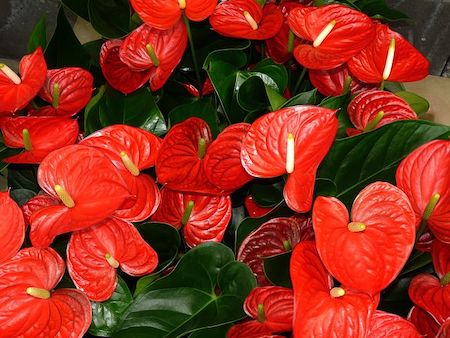
A tropical plant that boasts bright vivid colored blooms, the Anthurium Plant does very well indoors as long as there is moist soil. Native to tropical rainforests, they prefer high humidity, so decorating a bathroom with one is ideal. The Anthurium is an epiphyte that will attach itself to trees, and gather water and nutrients from the air.
A cousin to the peace lily plant, it features woody roots. Flowers have a spadix hooded by a vibrant spathe with numerous tiny flowers. Spathes can be found in pink, salmon, bright red, and even variegated patterns.
With the correct care, this plant will bloom all year round. Low to moderate filtered indirect light is best.
- Light: Low to moderate filtered indirect light
- Water: Keep the soil evenly moist
- Size: Up to 2 feet
- Leaf Colors: Green leaves, colorful spathes in pink, red, and salmon
- Difficulty of Care: Moderate, requires high humidity
30. Peace Lily Plant
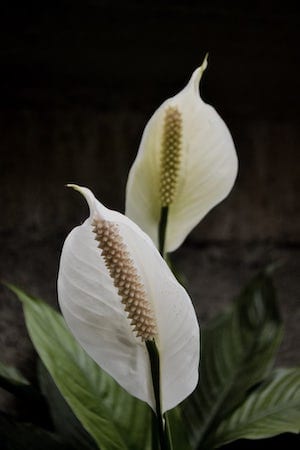
These are excellent low-light plants par excellence! The Peace Lily, Spathiphyllum, produces large, elongated oval-shaped leaves in a dark green hue bringing elegance to any room. However, they will also reward plant parents with lovely white hooded flowers that can last up to two months.
The peace lily likes plenty of water. If you see the leaves dropping, it’s letting you know that the plant is thirsty. Not an authentic lily, even if the bloom resembles one, it is toxic to pets. They do exceptionally well in low-light conditions.
- Light: Low to medium indirect light
- Water: When leaves begin to droop
- Size: Up to 3 feet
- Leaf Colors: Dark green
- Difficulty of Care: Easy to moderate
Low Light Plants Final Thoughts
These true low light houseplants offer something different than your average houseplant. Some are more suited to office environments while others thrive in areas where natural sunlight isn’t available.
Regardless of which type you choose, I hope you enjoy them and find success growing them.
Here are guides for other popular houseplants that are good in low-light locations:

